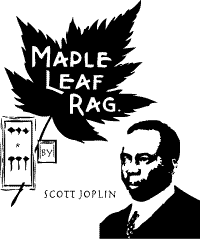|
|
Sound Examples: Teasers |
Rhythm and Transforms is accompanied by a CD-ROM that contains many sound examples in .mp3 format that are playable in iTunes, Windows Media Player, Quicktime, or almost any other audio program. The sound examples are an integral part of the book. You will miss many of the most important aspects of the presentation if you do not "listen along." This page presents a few highlights, tidbits of sound that suggest some of the results and sound manipulations that are possible using beat-oriented audio processing.
One of the primary examples used throughout Rhythm and Transforms for sound demonstrations is the Maple Leaf Rag, a ragtime masterpiece composed at the start of the twentieth century by Scott Joplin. The Maple Leaf Rag became the most popular piano tune of its era, selling over one million copies of the sheet music. A reproduction of the cover of the original sheet music is shown below along with a portrait of Joplin. Joplin's music enjoyed a revival in the 1970s when the copyrights expired and his work entered the public domain. Because there are no legal complications, it is possible to freely augment, manipulate, expand, and mutilate the music. Ragtime literally means "time in tatters," and I would like to imagine that Joplin would not be offended by the temporal shredding and rhythmic splintering that follows.

Julie's Waltz by Mark Schatz provides a detailed case study in Chapter 11 of how beat-based feature scores can display detailed information about aspects of a musical performance (such as timing and timbre) that are missing from a standard musical score.
The little-known song Soul (written by Phil Schniter and Ruby Beil) and performed by the (now defunct) Ithaca-based band Blip is also used extensively to demonstrate the various techniques of sound manipulation in a vocal rock context. Successful beat-tracking of Soul is demonstrated in SoulTap. The Soul Waltzes show that hard driving rhythms need not be confined to 4/4 time signatures. Atonal Soul, Noisy Souls, and Frozen Souls demonstrate the removal of all tonal material, the elaboration of the noise component, and textural changes due to spectral freezing. The effects of the processing on Beil's voice are often remarkable: sometimes silly and sometimes frightening. These examples give only a taste of the possibilities.